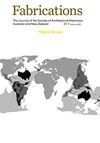On the Verge of Neo-Imperialism and Neutrality: The Construction of the Belgian Consulate-General in Seoul (1903-1907)
IF 0.3
0 ARCHITECTURE
Fabrications-The Journal of the Society of Architectural Historians Australia and New Zealand
Pub Date : 2022-09-02
DOI:10.1080/10331867.2023.2184081
引用次数: 0
Abstract
ABSTRACT This article frames the design and construction of the Belgian Consulate-General in Seoul (1903-1907) as a project of national representation on the verge of neo-imperialism and neutrality. The building project, designed by Belgian architect A. Groothaert, was part of the Belgian mission to showcase itself as an economic, commercial and industrial power via diplomatic architecture. The article discusses the design and building process paying particular attention to the materiality of the building. It analyses how this project and the selection of Belgian building materials were guided by aspirations to promote national industry and commerce; which were however continuously impacted by the difficulties imposed by the longdistance organisational model Brussels-Seoul, and the limitations in budget and resources of the small-state power that Belgium was at the time, as well as the rapidly changing political reality of Korea. Moreover, the article highlights how diplomatic architecture was used by a neutral country to channel its neo-imperial ambitions. In doing so it also underlines the importance of broadening the research perspective on diplomatic architecture to include consular buildings, as in the case of neutral and secondary states economic and commercial considerations often prevailed over political ambitions.新帝国主义与中立的边缘:比利时驻首尔总领事馆的建设(1903-1907)
摘要本文将比利时驻首尔总领事馆(1903-1907)的设计和建设视为一个处于新帝国主义和中立边缘的国家代表性项目。该建筑项目由比利时建筑师A.Groothaert设计,是比利时通过外交建筑展示自己作为经济、商业和工业大国的使命的一部分。文章讨论了设计和建造过程,特别注意建筑的物质性。它分析了该项目和比利时建筑材料的选择是如何以促进国家工业和商业的愿望为指导的;然而,它们不断受到布鲁塞尔-首尔远程组织模式带来的困难、比利时当时的小国预算和资源限制以及韩国迅速变化的政治现实的影响。此外,这篇文章强调了一个中立国家是如何利用外交架构来引导其新帝国主义野心的。在这样做的过程中,它还强调了扩大外交建筑研究视角以包括领事建筑的重要性,就像在中立国和次要国家的情况下一样,经济和商业考虑往往压倒政治野心。
本文章由计算机程序翻译,如有差异,请以英文原文为准。
求助全文
约1分钟内获得全文
求助全文
来源期刊

CiteScore
0.50
自引率
25.00%
发文量
26
 求助内容:
求助内容: 应助结果提醒方式:
应助结果提醒方式:


